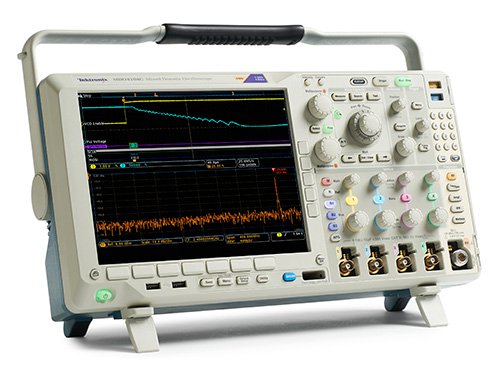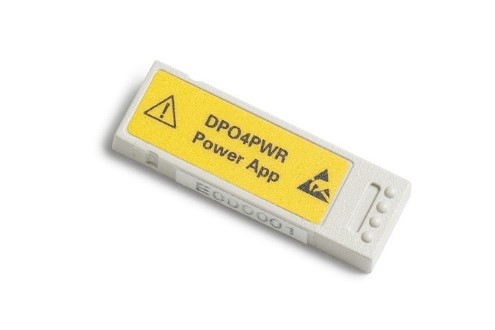


Mark Briscoe, product planner for the MDO4000C, with the new upgradeable oscilloscope and a TM500, one of the original upgradeable instrument systems. (In the spirit of full-disclosure, Mark was in elementary school when the TM500 came out. He didn’t work on that project.)
Significant planning and engineering has to happen for any new piece of test instrumentation, but adding in the ability for upgradeability layers on a number of unique challenges. Your design team may be facing some of these challenges in your current project such as:
· How do you protect performance and reliability as you add functions?
· How do you make configuration easy for users?
· How do you implement post-purchase upgrades?
· How do you deal with model numbering?
These challenges and more were encountered by the Tektronix engineering team designing the new MDO4000C oscilloscope. They recently transitioned the platform from a fixed set of configurations to a fully configurable, upgradeable oscilloscope. To learn more, I sat down with Mark Briscoe, the product planner for the program, to get his take on these challenges and how the team approached them.
How did you determine that upgradeability should be such a high priority for the design team?
Upgradeable instrumentation has been around for decades, dating back to the beginning of modular instrumentation like the old Tek TM500 products. Customers, back then, were drawn to being able to add functionality to a measurement system over time. As modern test instrumentation, and oscilloscopes specifically, have evolved, customers have been interested in using fewer pieces of test instrumentation to do more and in the ability to upgrade as their needs change, or as funding frees up.
Our thinking for the MDO4000C in particular was strongly influenced by the success of the MDO3000 in the midrange scope market. The MDO3000 introduced upgradeable digital channels, arbitrary/function generator, digital voltmeter, analog bandwidth, and spectrum analyzer. This flexibility has been really well-received by users.
Customers of oscilloscopes also need to be able to move quickly from one set of features to another, and software upgradeability can provide this. Similarities exist in the consumer world; like adding apps to smart phones, or purchasing new games for game consoles. Even television set top boxes are adding new functionality over time as a way to increase value to their customers.
We did research that told us that scope customers at all performance levels value upgradeability. We learned that the average replacement cycle for a midrange oscilloscope is between five and seven years. With the average design project lasting only 12 months (or less), that means that a single oscilloscope needs to live through multiple projects over its lifetime.
How much energy went into making the platform upgradeable?
Right from the start, we approached the definition of the MDO4000C from the perspective of making it highly upgradeable. This meant our entire mindset was focused on enabling upgradeability whenever possible. To do this meant leveraging existing methods of upgrading software capabilities like adding serial bus analysis or automated power measurements using our plug-in application modules. This approach allows users to quickly add new functionality to existing instruments or move software functions from one instrument to another.
We also structured the configuration of the instrument series to be more “base model plus options” so that customers could easily configure the product to reflect what their current needs are, and leave open the possibilities of adding functions or performance in the future.

Hardware “application modules” allow users to add measurement functions in the field and transfer those functions between instruments.
What’s upgradeable in the MDO4000C? How has this changed from the B-version?
The new “C” version inherited some of its upgradeability from the earlier “B” version. Both versions let you add serial bus analysis by plugging in application modules. Automated power measurements, and limit and mask test are also added with application modules.
The “B” version had hard-configured models that offered 16 digital channels and a spectrum analyzer input, but these functions weren’t upgradeable. In the new version digital channels can be added later, in the field. The spectrum analyzer can also be added or upgraded later by sending the instrument to a service center for hardware changes and calibration.
The 4000C adds an option for a built-in function generator. It also adds a hardware DVM that can be enabled for free when a customer registers their product with Tektronix. A simple software key is used to enable the DVM.
If you want to upgrade analog bandwidth on the 4000C, you can. Bandwidth upgrades weren’t available on the “B” version.
What did you consider “must haves” in terms of performance or functions?
Extensive customer research told us that oscilloscope users are using other types of test equipment regularly as well. It was important for us to focus on integrating the most important of those types so that customers would be able to leverage the increased functionality. This included spectrum analysis, digital channels, function generation, DVM, and serial protocol analysis.
What was critical to us was the spectrum analyzer. This is the number one requested instrument type to integrate by users of midrange scopes. And the technology that Tektronix has enables us to offer this to our customers. We considered other instrument types, but we’ll just have to wait and see what the future holds for those.
A clear goal for us was to provide integrated functionality that was upgradeable, without compromising on the performance of any of those instrument functions. Thankfully, we had decades of design experience in logic analyzers, spectrum analyzers, protocol analysis and signal sources to draw on. We were able to use in-house high-performance ASIC technology that enabled us to build an extensive platform and offer an extreme level of integration at a price point far less than equivalent stand-alone instruments.
And we needed to build a platform that could be easily modified in all regions of the world either by our customers in the field (for some capabilities) or by our service centers. Any instrument capability that is field configurable had to be stable over time so that customers could turn it on and it just works. Any piece of hardware on our oscilloscopes does need to have performance verification and calibration on a regular basis, but we needed to make sure that within that window, the products would perform to our stringent specifications.
Lastly, because the oscilloscope remains the center of most design benches, it was important for our user interface to operate like a scope. We didn’t want to recreate our standalone AFG user interface on the scope, for example. It wouldn’t make sense. We wanted to have the additional functionality fit seamlessly into the existing oscilloscope UI.
What were a few of the key considerations for the upgrade process?
We looked for opportunities to include hardware functions on all base models to make the upgrade process for the customer easy whenever possible. This is why each product ships with the hardware for MSO, AFG, and DVM functionality. And all of these can be easily enabled in the field by the customer. To make that last part easy for the customer, we sell upgrade kits that are stocked at our distributors around the world, making access to the upgrades quick and convenient.
One other important aspect is having a service organization and manufacturing organization that are in lockstep with the design team’s goals of providing the feature set to any customer, anywhere in the world. We worked with Tektronix service centers around the world to get them ready to reconfigure hardware and calibrate instruments that are being upgraded. There were a number of new processes and test configurations that needed to be rolled out to support this capability. For example, we had to redesign our service database to record new kinds of configuration changes.
Additionally, we worked to ensure that the instrument firmware is smart enough to configure itself in the proper fashion depending on the hardware configuration and/or what software options are installed. It was critical that we architected things from the beginning with this in mind.
What advice do you have for engineering teams working on field or customer upgradeable systems?
Most of our success on the MDO4000C was based on having a mindset from the start to build the best product for our customers. Start with the customer requirements, and be as specific as possible on what the key requirements are. Work from there to manage internal groups that may need to change processes and have frequent milestones or checkpoints to validate progress, but don’t forget about implications to your sales and support channels. For us, that also meant taking into consideration the needs of our distribution channel worldwide to make sure we were making things easy for them wherever possible.
UPDATE:
For hands-on experience using the MDO4000C to get your Mixed Signal Embedded designs to market faster, join us at either of our two FREE hands-on Troubleshooting Embedded/Wireless Systems workshops:


